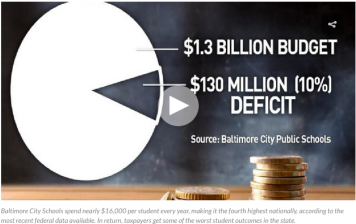Public School Numbers Games Hide What Matters
I drafted this piece on Saturday, March 25, 2017, when no one knew if or how much money Governor Larry Hogan would “give” to Baltimore City Public Schools in his second supplemental budget. My child’s school was facing a 20 percent cut to our budget. I updated it on the 27th, when Hogan announced his add for City Schools. Now it looks like my child’s school budget will be cut 5 percent. I’ll just leave this here. I have been told it deserves to be shared.
On March 27, the governor of Maryland announced a plan to allocate to Baltimore City Public Schools an additional $23.7 million, which represents a small fraction of a multi-million dollar budget gap. For advocates like me, a big trick of fighting for funding has been figuring out what to show to illustrate projected losses: a dollar sign, a percentage, an image of a classroom with 25 students next to the same one with 40?
The figure Baltimore City Public Schools CEO Sonja Santelises presented, and then leaders of the Downtown Baltimore Family Alliance ran with, and now Fox45 News is promoting to particularly misleading effect, is $130 million. That is the amount – rounded up by one to the nearest 10 – of the structural deficit that City Schools lacks the revenue to fill this year, and next year, and the year after that.  Divided by the average teacher salary, it signifies more than 1,000 positions, rounded down by hundreds. In a panic that elided the need for a three-year fix, DBFA branded a campaign #releasethe130. In a simple pie chart, Fox45 reduced the 130 to a sliver – 10 percent – of the school system’s $1.3 billion budget.
Divided by the average teacher salary, it signifies more than 1,000 positions, rounded down by hundreds. In a panic that elided the need for a three-year fix, DBFA branded a campaign #releasethe130. In a simple pie chart, Fox45 reduced the 130 to a sliver – 10 percent – of the school system’s $1.3 billion budget.
 Divided by the average teacher salary, it signifies more than 1,000 positions, rounded down by hundreds. In a panic that elided the need for a three-year fix, DBFA branded a campaign #releasethe130. In a simple pie chart, Fox45 reduced the 130 to a sliver – 10 percent – of the school system’s $1.3 billion budget.
Divided by the average teacher salary, it signifies more than 1,000 positions, rounded down by hundreds. In a panic that elided the need for a three-year fix, DBFA branded a campaign #releasethe130. In a simple pie chart, Fox45 reduced the 130 to a sliver – 10 percent – of the school system’s $1.3 billion budget.
Fox45’s coverage hands rural Marylanders ammunition to fight spending on the big city. “Baltimore City Schools spend nearly $16,000 per student every year, making it the fourth highest nationally, according to the most recent federal data available,” Fox asserts. “In return, taxpayers get some of the worst student outcomes in the state.” Countless “school reform” pushers and county politicians have used the same talking point, neglecting to mention that Baltimore has the highest rate of concentrated poverty, the highest percentage of students with special needs, the highest number of lead poisoned children. Their point: Money is wasted on Baltimore.
Also lost in the discussion of $130 million are the figures by which Baltimore City Public Schools have been underfunded for years. City Schools would have no deficit at all if the state had not cut the inflation adjustment nine years ago. If not for a decade of flat funding and rising costs, we would have at least $290 million more revenue this year, from the state alone. That does make $130 million seem small, not to mention $23.7 million.
Moreover, a state study released in late 2016 found that Baltimore City Public Schools would need an additional $350 million from the state to meet a funding level adequate to enable students to meet state standards. In three years, when the commission working on a revised state funding formula arrives at one that is fair and equitable, one can only hope for the sake of all students in Maryland that the governor fully funds it.
What no one in the media has looked at is what happens to the 10 percent district-level deficit when you distribute it across schools. It balloons.
My child goes to a Pre-K–Grade 8 public school in Baltimore City with more than 700 other students. The school touts low teacher turnover, a middle school Ingenuity program, a recently won E-GATE certification for gifted and advanced learning instruction, Public School Numbers Games Hide What Matters | Re:education in Baltimore:



